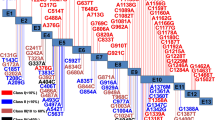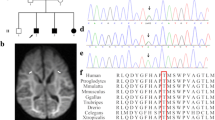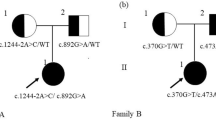Abstract
AGC2, a member of the mitochondrial carrier protein family, is as an aspartate-glutamate carrier and is important for urea synthesis and the maintenance of the malate-aspartate shuttle. Mutations in SLC25A13, the gene encoding AGC2, result in two age dependent disorders: neonatal intrahepatic cholestasis caused by citrin deficiency (NICCD) and type II citrullinemia (CTLN2). The clinical features of CTLN2 are very similar to those of other urea cycle disorders making a clear diagnosis difficult. Analysis of the SLC25A13 gene sequence can provide a definitive diagnosis, however the predictive value of DNA sequencing requires that the disease association of variants be characterized. We utilized the yeast Saccharomyces cerevisiae lacking AGC1 as a model system to study the effect on the function of AGC2 variants and confirmed that this system is capable of distinguishing between AGC2 variants with normal (p.Pro632Leu) or impaired function (p.Gly437Glu, p.Gly531Asp, p.Thr546Met, p.Leu598Arg and p.Glu601Lys). Three novel AGC2 genetic variants, p.Met1? (c.2T>C), p.Pro502Leu (c.1505C>T), and p.Arg605Gln (c.1814G>A) were investigated and our analysis revealed that p.Pro502Leu and p.Arg605Gln substitutions in the AGC2 protein were without effect and these variants were fully functional. The p.Met1? mutant is capable of expressing a truncated p.Met1_Phe34del AGC2 variant, however this protein is not functional due to disruptions in a calcium binding EF hand as well as incorrect intracellular localization. Our study demonstrates that the characterization of AGC2 expressed in yeast cells is a powerful technique to investigate AGC2 variants, and this analysis should aid in establishing the disease association of novel variants.





Similar content being viewed by others
Abbreviations
- AGC:
-
aspartate-glutamate carrier
- NICCD:
-
neonatal intrahepatic cholestasis caused by citrin deficiency
- CTLN2:
-
type II citrullinemia
- MCF:
-
mitochondrial carrier family
References
Akke M, Drakenberg T, Chazin WJ (1992) Three-dimensional solution structure of Ca(2+)-loaded porcine calbindin D9k determined by nuclear magnetic resonance spectroscopy. Biochemistry 31(4):1011–1020
Aronov S, Gelin-Licht R, Zipor G, Haim L, Safran E, Gerst JE (2007) mRNAs encoding polarity and exocytosis factors are cotransported with the cortical endoplasmic reticulum to the incipient bud in Saccharomyces cerevisiae. Mol Cell Biol 27(9):3441–3455
Balcavage WX, Mattoon JR (1968) Properties of Saccharomyces cerevisiae mitochondria prepared by a mechanical method. Biochim Biophys Acta 153(3):521–530
Begum L, Jalil MA, Kobayashi K et al (2002) Expression of three mitochondrial solute carriers, citrin, aralar1 and ornithine transporter, in relation to urea cycle in mice. Biochim Biophys Acta 1574(3):283–292
Bordoli L, Kiefer F, Arnold K, Benkert P, Battey J, Schwede T (2009) Protein structure homology modeling using SWISS-MODEL workspace. Nat Protoc 4(1):1–13
Brachmann CB, Davies A, Cost GJ et al (1998) Designer deletion strains derived from Saccharomyces cerevisiae S288C: a useful set of strains and plasmids for PCR-mediated gene disruption and other applications. Yeast 14:115–132
Cavero S, Vozza A, del Arco A et al (2003) Identification and metabolic role of the mitochondrial aspartate-glutamate transporter in Saccharomyces cerevisiae. Mol Microbiol 50(4):1257–1269
Contreras L, Gomez-Puertas P, Iijima M, Kobayashi K, Saheki T, Satrustegui J (2007) Ca2+ activation kinetics of the two aspartate-glutamate mitochondrial carriers, aralar and citrin: role in the heart malate-aspartate NADH shuttle. J Biol Chem 282(10):7098–7106
Cullin C, Minvielle-Sebastia L (1994) Multipurpose vectors designed for the fast generation of N- or C-terminal epitope-tagged proteins. Yeast 10(1):105–112
del Arco A, Agudo M, Satrustegui J (2000) Characterization of a second member of the subfamily of calcium-binding mitochondrial carriers expressed in human non-excitable tissues. Biochem J 345(Pt 3):725–732
den Dunnen JT, Antonarakis SE (2000) Mutation nomenclature extensions and suggestions to describe complex mutations: a discussion. Hum Mutat 15(1):7–12
Dimmock D, Maranda B, Dionisi-Vici C et al (2009) Citrin deficiency, a perplexing global disorder. Mol Genet Metab 96(1):44–49
Fiermonte G, Parisi G, Martinelli D et al (2011) A new Caucasian case of neonatal intrahepatic cholestasis caused by citrin deficiency (NICCD): a clinical, molecular, and functional study. Mol Genet Metab 104(4):501–506
Fu HY, Zhang SR, Wang XH, Saheki T, Kobayashi K, Wang JS (2011) The mutation spectrum of the SLC25A13 gene in Chinese infants with intrahepatic cholestasis and aminoacidemia. J Gastroenterol 46(4):510–518
Gietz RD, Schiestl RH (1991) Applications of high efficiency lithium acetate transformation of intact yeast cells using single-stranded nucleic acids as carrier. Yeast 7(3):253–263
Hachisu M, Oda Y, Goto M et al (2005) Citrin deficiency presenting with ketotic hypoglycaemia and hepatomegaly in childhood. Eur J Pediatr 164(2):109–110
Hartwell LH (2004) Yeast and cancer. Biosci Rep 24(4–5):523–544
Hobbs AE, Srinivasan M, McCaffery JM, Jensen RE (2001) Mmm1p, a mitochondrial outer membrane protein, is connected to mitochondrial DNA (mtDNA) nucleoids and required for mtDNA stability. J Cell Biol 152(2):401–410
Hughes AL, Powell DW, Bard M et al (2007) Dap1/PGRMC1 binds and regulates cytochrome P450 enzymes. Cell Metab 5(2):143–149
Iijima M, Jalil A, Begum L et al (2001) Pathogenesis of adult-onset type II citrullinemia caused by deficiency of citrin, a mitochondrial solute carrier protein: tissue and subcellular localization of citrin. Adv Enzyme Regul 41:325–342
Ikeda S, Kawa S, Takei Y et al (2004) Chronic pancreatitis associated with adult-onset type II citrullinemia: clinical and pathologic findings. Ann Intern Med 141(7):W109–W110
Jensen LT, Carroll MC, Hall MD, Harvey CJ, Beese SE, Culotta VC (2009) Down-regulation of a manganese transporter in the face of metal toxicity. Mol Biol Cell 20(12):2810–2819
Kobayashi K, Saheki T (1993) Citrin deficiency
Kobayashi K, Sinasac DS, Iijima M et al (1999) The gene mutated in adult-onset type II citrullinaemia encodes a putative mitochondrial carrier protein. Nat Genet 22(2):159–163
Kobayashi K, Ushikai M, Song Y-Z et al (2008) Overview of citrin deficiency: SLC25A13 mutations and the frequency. J Appl Clin Pediatr 23(20):1553–1557
Komatsu M, Yazaki M, Tanaka N et al (2008) Citrin deficiency as a cause of chronic liver disorder mimicking non-alcoholic fatty liver disease. J Hepatol 49(5):810–820
Kunji ER (2004) The role and structure of mitochondrial carriers. FEBS Lett 564(3):239–244
Lasorsa FM, Pinton P, Palmieri L, Fiermonte G, Rizzuto R, Palmieri F (2003) Recombinant expression of the Ca(2+)-sensitive aspartate/glutamate carrier increases mitochondrial ATP production in agonist-stimulated Chinese hamster ovary cells. J Biol Chem 278(40):38686–38692
Lu YB, Kobayashi K, Ushikai M et al (2005) Frequency and distribution in East Asia of 12 mutations identified in the SLC25A13 gene of Japanese patients with citrin deficiency. J Hum Genet 50(7):338–346
Mutoh K, Kurokawa K, Kobayashi K, Saheki T (2008) Treatment of a citrin-deficient patient at the early stage of adult-onset type II citrullinaemia with arginine and sodium pyruvate. J Inherit Metab Dis 31(Suppl 2):S343–S347
Nagasaka H, Okano Y, Tsukahara H et al (2009) Sustaining hypercitrullinemia, hypercholesterolemia and augmented oxidative stress in Japanese children with aspartate/glutamate carrier isoform 2-citrin-deficiency even during the silent period. Mol Genet Metab 97(1):21–26
Palmieri F (2004) The mitochondrial transporter family (SLC25): physiological and pathological implications. Pflugers Arch 447(5):689–709
Palmieri F (2008) Diseases caused by defects of mitochondrial carriers: a review. Biochim Biophys Acta 1777(7–8):564–578
Palmieri L, Pardo B, Lasorsa FM et al (2001) Citrin and aralar1 are Ca(2+)-stimulated aspartate/glutamate transporters in mitochondria. EMBO J 20(18):5060–5069
Palmieri F, Agrimi G, Blanco E et al (2006) Identification of mitochondrial carriers in Saccharomyces cerevisiae by transport assay of reconstituted recombinant proteins. Biochim Biophys Acta 1757(9–10):1249–1262
Pebay-Peyroula E, Dahout-Gonzalez C, Kahn R, Trezeguet V, Lauquin GJ, Brandolin G (2003) Structure of mitochondrial ADP/ATP carrier in complex with carboxyatractyloside. Nature 426(6962):39–44
Perocchi F, Mancera E, Steinmetz LM (2008) Systematic screens for human disease genes, from yeast to human and back. Mol Biosyst 4(1):18–29
Pfanner N, Hoeben P, Tropschug M, Neupert W (1987) The carboxyl-terminal two-thirds of the ADP/ATP carrier polypeptide contains sufficient information to direct translocation into mitochondria. J Biol Chem 262(31):14851–14854
Ralser M, Heeren G, Breitenbach M, Lehrach H, Krobitsch S (2006) Triose phosphate isomerase deficiency is caused by altered dimerization–not catalytic inactivity–of the mutant enzymes. PLoS One 1:e30
Ramos M, del Arco A, Pardo B et al (2003) Developmental changes in the Ca2+-regulated mitochondrial aspartate-glutamate carrier aralar1 in brain and prominent expression in the spinal cord. Brain Res Dev Brain Res 143(1):33–46
Saheki T, Kobayashi K (2002) Mitochondrial aspartate glutamate carrier (citrin) deficiency as the cause of adult-onset type II citrullinemia (CTLN2) and idiopathic neonatal hepatitis (NICCD). J Hum Genet 47(7):333–341
Saheki T, Kobayashi K, Iijima M et al (2005) Metabolic derangements in deficiency of citrin, a liver-type mitochondrial aspartate-glutamate carrier. Hepatol Res 33(2):181–184
Schwede T, Kopp J, Guex N, Peitsch MC (2003) SWISS-MODEL: an automated protein homology-modeling server. Nucleic Acids Res 31(13):3381–3385
Sherman F, Fink GR, Lawrence CW (1978) Methods in yeast genetics. Cold Spring Harbor Laboratory Press, Cold Spring Harbor
Sikorski RS, Hieter P (1989) A system of shuttle vectors and yeast host strains designed for efficient manipulation of DNA in Saccharomyces ceresiviae. Genetics 122:19–27
Sirrenberg C, Endres M, Folsch H, Stuart RA, Neupert W, Brunner M (1998) Carrier protein import into mitochondria mediated by the intermembrane proteins Tim10/Mrs11 and Tim12/Mrs5. Nature 391(6670):912–915
Soeda J, Yazaki M, Nakata T et al (2008) Primary liver carcinoma exhibiting dual hepatocellular-biliary epithelial differentiations associated with citrin deficiency: a case report. J Clin Gastroenterol 42(7):855–860
Song YZ, Ushikai M, Sheng JS, Iijima M, Kobayashi K (2007) SLC25A13 gene mutation analysis in a pedigree of neonatal intrahepatic cholestasis caused by citrin deficiency. Zhonghua Er Ke Za Zhi 45(6):408–412
Steinmetz LM, Scharfe C, Deutschbauer AM et al (2002) Systematic screen for human disease genes in yeast. Nat Genet 31(4):400–404
Sundin BA, Chiu CH, Riffle M, Davis TN, Muller EG (2004) Localization of proteins that are coordinately expressed with Cln2 during the cell cycle. Yeast 21(9):793–800
Tabata A, Sheng JS, Ushikai M et al (2008) Identification of 13 novel mutations including a retrotransposal insertion in SLC25A13 gene and frequency of 30 mutations found in patients with citrin deficiency. J Hum Genet 53(6):534–545
Vriend G (1990) Parameter relation rows: a query system for protein structure function relationships. Protein Eng 4(2):221–223
Yamaguchi N, Kobayashi K, Yasuda T et al (2002) Screening of SLC25A13 mutations in early and late onset patients with citrin deficiency and in the Japanese population: identification of two novel mutations and establishment of multiple DNA diagnosis methods for nine mutations. Hum Mutat 19(2):122–130
Yazaki M, Takei Y, Kobayashi K, Saheki T, Ikeda S (2005) Risk of worsened encephalopathy after intravenous glycerol therapy in patients with adult-onset type II citrullinemia (CTLN2). Intern Med 44(3):188–195
Acknowledgements
This work was supported by a joint grant from Mahidol University Faculty of Science and Ramathibodi Hospital Faculty of Medicine (LJ and DW), Mahidol University (DW), and the Medical Scholars Program of Mahidol University (PW). DW is a recipient of Research Career Development Award, Faculty of Medicine Ramathibodi Hospital. We thank Araceli del Arco and Jeffrey Gerst for their gifts of yeast strains and plasmids. In addition we thank Mathurose Ponglikitmongkol for helpful discussions and suggestions and Amornrat Naranuntarat Jensen for assistance with fluorescence microscopy, helpful discussions, and critical reading of the manuscript.
Details of funding
This work was supported by a joint grant from Mahidol University Faculty of Science and Faculty of Medicine Ramathibodi Hospital (LJ and DW), Mahidol University (DW), and the Medical Scholars Program of Mahidol University (PW). The authors confirm that this work was independent and that the sponsors did not influence the content of the article.
Conflict of interest
None.
Author information
Authors and Affiliations
Corresponding author
Additional information
Communicated by: Gajja Salomons
Electronic supplementary materials
Below is the link to the electronic supplementary material.
Fig. S1
Growth of yeast agc1∆ mutants and complementation by human AGC2. The agc1∆ yeast strain PW001 transformed with human AGC2 (pYX142-AGC2) or the empty vector (pRS425) were tested for growth in synthetic medium containing acetate (100 mM), galactose (2 %), glycerol (2 %) and ethanol (2 %) as carbon sources. Cell growth was monitored by measuring A600 nm and is shown as % of AGC2 expressing cells. Cells expressing human AGC2 are displayed as white bars and the empty vector is shown as black bars. Results for 72 hours of growth are shown. Yeast agc1∆ mutants without human AGC2 display poor growth in medium containing acetate but not other carbon sources tested. (JPEG 11 kb)
Fig. S2
DNA sequence of the N-terminal region of AGC2 showing three potential translation initiation sites. A) The standard translation start site is indicated by M1 and the two downstream potential sites are labeled M2 (out of frame) and M3 (p.Met1_Phe34del producing). The translated amino acid sequence for this region for M2 and M3 is shown below the DNA codons in panels B and C respectively. Use of M3 will result in expression of p.Met1_Phe34del AGC2. (JPEG 9 kb)
Fig. S3
Wild type and p.Met1_Phe34del AGC2 exhibit similar rates of degradation. Wild type AGC2-GFP (pPW015) (Panel A) and p.Met1_Phe34del GFP (pPW016) (Panel B) in strain PW001 (agc1∆) were monitored in crude mitochondrial extracts from cultures grown in YPR+0.5 % galactose medium for 16 hours followed by addition of glucose to 2 % to represses expression. Time points are after addition of glucose. AGC2-GFP remaining was monitored using immunoblots with an anti-GFP antibody. As a loading control the levels of porin were monitored. C) Densitometric analysis of AGC2-GFP or p.Met1_Phe34del AGC2-GFP was measured using ImageJ 1.45S software. Results are normalized based on porin levels and presented as percent of AGC2 prior to addition of glucose. White bars represent wild type AGC2 and black bars p.Met1_Phe34del AGC2. (JPEG 30 kb)
Fig. S4
Homology model of the AGC2 N-terminal domain showing sequences absent in p.Met1_Phe34del AGC2. A model of the AGC2 N-terminal region was generated using porcine calbindin D9k (1cb1) (Akke, Drakenberg et al 1992) as a template. Amino acid residues 1–34 are shown in white and all other sequences are gray. A) Ribbon diagram of the N-terminal domain with the position of M35, EF1 and EF2 indicated. B) Space-filling representation showing contacts between residues 1–34 and other regions of the N-terminal domain. (JPEG 26 kb)
Fig. S5
Topology model of AGC2 showing location of variants tested. Variants that result in reduced complementation of the agc1∆ strain are shown in black and those that exhibited wild type activity are shown in white. (JPEG 10 kb)
Supplemental material
(DOC 81 kb)
Rights and permissions
About this article
Cite this article
Wongkittichote, P., Tungpradabkul, S., Wattanasirichaigoon, D. et al. Prediction of the functional effect of novel SLC25A13 variants using a S. cerevisiae model of AGC2 deficiency. J Inherit Metab Dis 36, 821–830 (2013). https://doi.org/10.1007/s10545-012-9543-5
Received:
Revised:
Accepted:
Published:
Issue Date:
DOI: https://doi.org/10.1007/s10545-012-9543-5




